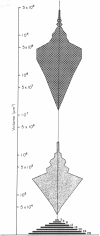Abstract
There is increasing evidence that developmental associations among embryonic cells are mediated by specific components of the cell surface. Earlier work has indicated that such components are extruded into the medium of primary monolayer cultures of embryonic cells, and that they represent the active constituents of the tissue-spedific cell-aggregating factors isolated fro- the supernatant medium of such cultures. We presently report that tissue-specific cell-aggregating factors can be obtained directly from embryonic tissues, and describe the isolation and partial purification of retina-spedific factor from a cell-membrane preparation derived from retina tissue of the chick embryo. Extraction of the purified membrane preparation with 1-butanol yielded an activity in the aqueous phase which resides in a protein probably a glycoprotein, with an estimated molecular weight of 50,000 in solution. This material could be obtained from retinas of embryos not older than 13 days, and only pre-13-day cells responded to its cell-aggregating activity. By these characteristics, this membrane-derived retina factor closely resembles the retina cell-aggregating glycoprotein previously purified from the supernatant medium of retina cell cultures. It is of special interest that the cell-aggregating protein is obtainable from cellular membranes during those stages of development when retina cells are most actively engaged in histological organization. Work in progress indicates that, by the procedures described herein, tissue-specific cell-aggregating factors can also be obtained from membrane preparations of other embryonic tissues.
Full text
PDF




Images in this article
Selected References
These references are in PubMed. This may not be the complete list of references from this article.
- Balsamo J., Lilien J. Embryonic cell aggregation: kinetics and specificity of binding of enhancing factors. Proc Natl Acad Sci U S A. 1974 Mar;71(3):727–731. doi: 10.1073/pnas.71.3.727. [DOI] [PMC free article] [PubMed] [Google Scholar]
- Garber B. B., Moscona A. A. Reconstruction of brain tissue from cell suspensions. 2. Specific enhancement of aggregation of embryonic cerebral cells by supernatant from homologous cell cultures. Dev Biol. 1972 Feb;27(2):235–243. doi: 10.1016/0012-1606(72)90100-5. [DOI] [PubMed] [Google Scholar]
- Goldschneider I., Moscona A. A. Tissue-specific cell-surface antigens in embryonic cells. J Cell Biol. 1972 May;53(2):435–449. doi: 10.1083/jcb.53.2.435. [DOI] [PMC free article] [PubMed] [Google Scholar]
- Gottlieb D. I., Merrell R., Glaser L. Temporal changes in embryonal cell surface recognition. Proc Natl Acad Sci U S A. 1974 May;71(5):1800–1802. doi: 10.1073/pnas.71.5.1800. [DOI] [PMC free article] [PubMed] [Google Scholar]
- Hausman R. E., Moscona A. A. Cell-surface interactions: differential inhibition by proflavine of embryonic cell aggregation and production of specific cell-aggregating factor. Proc Natl Acad Sci U S A. 1973 Nov;70(11):3111–3114. doi: 10.1073/pnas.70.11.3111. [DOI] [PMC free article] [PubMed] [Google Scholar]
- Hausman R. E., Moscona A. A. Purification and characterization of the retina-specific cell-aggregating factor. Proc Natl Acad Sci U S A. 1975 Mar;72(3):916–920. doi: 10.1073/pnas.72.3.916. [DOI] [PMC free article] [PubMed] [Google Scholar]
- Hemminki K. Purification of plasma membranes from immature brain. FEBS Lett. 1973 Dec 15;38(1):79–82. doi: 10.1016/0014-5793(73)80518-6. [DOI] [PubMed] [Google Scholar]
- Hughes R. C., Sanford B., Jeanloz R. W. Regeneration of the surface glycoproteins of a transplantable mouse tumor cell after treatment with neuraminidase. Proc Natl Acad Sci U S A. 1972 Apr;69(4):942–945. doi: 10.1073/pnas.69.4.942. [DOI] [PMC free article] [PubMed] [Google Scholar]
- Kahan B. D., Reisfeld R. A. Transplantaton antigens. Science. 1969 May 2;164(3879):514–521. doi: 10.1126/science.164.3879.514. [DOI] [PubMed] [Google Scholar]
- Lilien J. E., Moscona A. A. Cell aggregation: its enhancement by a supernatant from cultures of homologous cells. Science. 1967 Jul 7;157(3784):70–72. doi: 10.1126/science.157.3784.70. [DOI] [PubMed] [Google Scholar]
- MOSCONA A., MOSCONA H. The dissociation and aggregation of cells from organ rudiments of the early chick embryo. J Anat. 1952 Jul;86(3):287–301. [PMC free article] [PubMed] [Google Scholar]
- MOSCONA A. Rotation-mediated histogenetic aggregation of dissociated cells. A quantifiable approach to cell interactions in vitro. Exp Cell Res. 1961 Jan;22:455–475. doi: 10.1016/0014-4827(61)90122-7. [DOI] [PubMed] [Google Scholar]
- MOSCONA M. H., MOSCONA A. A. INHIBITION OF ADHESIVENESS AND AGGREGATION OF DISSOCIATED CELLS BY INHIBITORS OF PROTEIN AND RNA SYNTHESIS. Science. 1963 Nov 22;142(3595):1070–1071. doi: 10.1126/science.142.3595.1070. [DOI] [PubMed] [Google Scholar]
- Maddy A. H. The properties of the protein of the plasma membrane of ox erythrocytes. Biochim Biophys Acta. 1966 Mar 28;117(1):193–200. doi: 10.1016/0304-4165(66)90166-8. [DOI] [PubMed] [Google Scholar]
- Martinozzi M., Moscona A. A. Binding of 125I-concanavalin A and agglutination of embryonic neural retina cells. Age-dependent and experimental changes. Exp Cell Res. 1975 Sep;94(2):253–266. doi: 10.1016/0014-4827(75)90491-7. [DOI] [PubMed] [Google Scholar]
- McClay D. R., Moscona A. A. Purification of the specific cell-aggregating factor from embryonic neural retina cells. Exp Cell Res. 1974 Aug;87(2):438–443. doi: 10.1016/0014-4827(74)90514-x. [DOI] [PubMed] [Google Scholar]
- Moscona A. A., Wiens A. W. Proflavine as a differential probe of gene expression: inhibition of glutamine synthetase induction in embryonic retina. Dev Biol. 1975 May;44(1):33–45. doi: 10.1016/0012-1606(75)90374-7. [DOI] [PubMed] [Google Scholar]
- Moscona M. H., Moscona A. A. Control of differentiation in aggregates of embryonic skin cells: suppression of feather morphogenesis by cells from other tissues. Dev Biol. 1965 Jun;11(3):402–423. doi: 10.1016/0012-1606(65)90047-3. [DOI] [PubMed] [Google Scholar]
- Rutishauser U., Thiery J. P., Brackenbury R., Sela B. A., Edelman G. M. Mechanisms of adhesion among cells from neural tissues of the chick embryo. Proc Natl Acad Sci U S A. 1976 Feb;73(2):577–581. doi: 10.1073/pnas.73.2.577. [DOI] [PMC free article] [PubMed] [Google Scholar]
- Truding R., Shelanski M. L., Morell P. Glycoproteins released into the culture medium of differentiating murine neuroblastoma cells. J Biol Chem. 1975 Dec 25;250(24):9348–9354. [PubMed] [Google Scholar]
- Warren L., Glick M. C. Membranes of animal cells. II. The metabolism and turnover of the surface membrane. J Cell Biol. 1968 Jun;37(3):729–746. doi: 10.1083/jcb.37.3.729. [DOI] [PMC free article] [PubMed] [Google Scholar]





